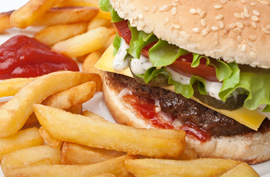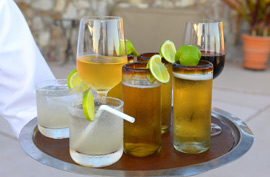 Pre-flight anxiety -- spurred by endless baggage lines, security checkpoints and screaming children -- need not extend to fears of repeat trips to the airplane lavatory. But eat the wrong thing before you fly, and you may be contending with more than just an awful in-flight movie or space-invading neighbor.
Pre-flight anxiety -- spurred by endless baggage lines, security checkpoints and screaming children -- need not extend to fears of repeat trips to the airplane lavatory. But eat the wrong thing before you fly, and you may be contending with more than just an awful in-flight movie or space-invading neighbor.
Unfortunately, airport dining options -- like a greasy fast food burger, oily pizza or a liquid lunch at the concourse bar -- are rather limited. Still, if you're disciplined, avoiding the gut-busting trifecta of grease, alcohol and carbonation can help contribute to a bloat-free flight. There are even a few surprisingly nutritious foods on our "don't eat" list that are best avoided before you take to the sky. And for the long-haulers wondering if there's anything to do to prevent jet lag as they zoom from New York to Beijing, there may just be a food-based remedy: eat nothing at all.
Remember to drink lots of water, eat some carrot sticks and nuts, and check out our five foods banned for pre-flight consumption.
 Eating Well and Staying Active While Traveling
Eating Well and Staying Active While Traveling
1. McDonald's Extra Value Meal
Okay, so we're using Mickey D's as the embodiment of greasy, artery-clogging fast food joints typically found in airports. According to the medical community, the body doesn't do so well digesting foods laden with sodium and saturated fats in the first place -- and digestion at 37,000 feet proves even more difficult. So it's common sense to avoid these worst offenders before flying.
But beyond the digestion problems, there's also the issue of in-flight blood circulation. Sitting squished and immobile in a pressurized cabin hinders blood flow, setting off a physiological chain that can lead to swollen feet, or worse, deep vein thrombosis (DVT). DVT involves the formation of a blood clot deep inside the body, that when breaks free can lodge in the brain, lungs or heart causing severe damage, even death. According to doctors at the 2012 Canadian Cardiovascular Congress – as reported by the Toronto Star -- scarfing down a greasy breakfast bacon, egg and cheese sandwich can further contribute to the constriction of blood flow. While no direct link has yet been made between DVT and eating a pre-flight meal high in saturated fats, fried chicken plus a cramped airline seat is probably a combination best avoided.
2. The Gas Giants
For obvious reasons, it's smart to avoid foods that encourage intestinal expansion, as the nature of the pressurized airplane cabin promotes further bloating. Chief among such foods are fried and super-saturated dishes, but even certain "healthful" foods -- onions, cauliflower, cabbage, baked beans -- can make you feel like an over-filled balloon.
And gas troubles can transcend questions of personal discomfort or public decency. In 2006, a flatulent airplane passenger forced an American Airlines plane to make an emergency landing. Fellow passengers reported smelling burnt matches, and the plane had to come down. A female passenger later admitted that she had struck the matches to conceal a certain aroma. The admission of guilt came after bomb-sniffing dogs discovered the extinguished matches.
 Healthiest Airport Food
Healthiest Airport Food
3. Alcohol
For many fliers, downing a few cocktails is part of their pre-flight protocol. It helps allay fear of flying, and serves as a liquid sleeping pill. But doctors (yes, them again) say that consuming alcohol before or during a flight should be avoided -- and it can actually contribute to passengers having trouble falling back asleep once they awaken.
 Eric Rimm, an associate professor of nutrition at the Harvard School of Public Health, tells Health Magazine: "Since there's less water in your blood when you're dehydrated, the concentration of alcohol will be slightly higher, leading to quicker intoxication and increased potential for a hangover." Still, many a traveler swears by the pre-flight or in-flight tipple; if having a pre-flight drink is a must for you, counteract the effect of the booze by consuming plenty of water.
Eric Rimm, an associate professor of nutrition at the Harvard School of Public Health, tells Health Magazine: "Since there's less water in your blood when you're dehydrated, the concentration of alcohol will be slightly higher, leading to quicker intoxication and increased potential for a hangover." Still, many a traveler swears by the pre-flight or in-flight tipple; if having a pre-flight drink is a must for you, counteract the effect of the booze by consuming plenty of water.
4. Carbonated Beverages
When flying, and especially on a long-haul, it helps to think of yourself as a super athlete, competing against the forces of dehydration, physical pain, rude flight attendants and the smelly guy sitting next to you. As an athlete, you'd never consume a Pepsi during a triathlon, would you? You need to be at your peak, and carbonated beverages are thought to contribute to bloating and cramping, two enemies of the long-haul athlete. Again, we're suggesting that you avoid foods that impede digestion, and that potentially cause distress to you and your fellow passengers. The people at Lufthansa put it succinctly on the company Website: "Try to avoid carbonated drinks such as cola because they cause wind and also have a diuretic effect."
 10 Ways to Survive a Long-Haul Flight
10 Ways to Survive a Long-Haul Flight
5. Everything
In a study published in the journal Science in 2008 -- and discussed in a New York Times article -- researchers suggested that fasting for about 16 hours before a long flight may actually help to fend off jet lag.
Here's the study in a nutshell: Normally it's light that triggers an internal clock that controls when we eat and sleep. But according to the study, a second clock seems to override the first when the body senses that food is in short supply. So researchers believe we might be able to faster adjust to time zone changes by manipulating this second clock, based on hunger. In essence, if you make your body think it's starving, you'll be able to remain awake and alert until it's dinner time in your new destination, resetting your body's light clock in the process.
Of course, we must stress that the study was conducted on lab rats, and the link has not been found in humans. But travelers desperate to avoid slumping over at 6 p.m. may wish to contribute to the study.